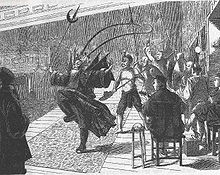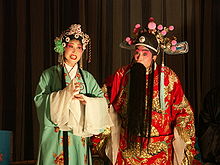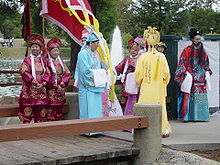- Chinese opera
-
Music of China 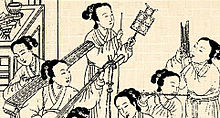
Timeline General topics Genres Specific forms Media and performance Music festivals Midi Modern Music Festival Music media National anthem Regional music Chinese opera (Chinese: 戏曲/戲曲; Pinyin: xìqǔ) is a popular form of drama and musical theatre in China with roots going back as far as the third century CE. There are numerous regional branches of Chinese opera, of which the Beijing opera (Jingju) is one of the most notable.
Contents
History
Dynastic periods
Canjun opera of the Three Kingdoms period was one of the first Chinese operatic forms.[1] Chinese opera in a more organized form began in the Tang Dynasty with Emperor Xuanzong (712–755), who founded the "Pear Garden" (梨园/梨園; líyuán), the first known opera troupe in China. The troupe mostly performed for the emperors' personal pleasure. To this day operatic professionals are still referred to as "Disciples of the Pear Garden" (梨园弟子/梨園弟子, líyuán dìzi).[2]
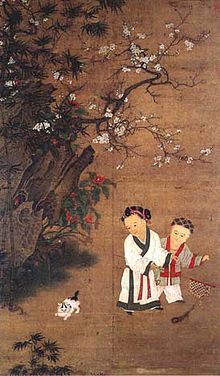 12th century painting by Su Hanchen; a girl waves a peacock feather banner like the one used in Song Dynasty dramatical theater to signal an acting leader of troops
12th century painting by Su Hanchen; a girl waves a peacock feather banner like the one used in Song Dynasty dramatical theater to signal an acting leader of troops
1279–1368
In the Yuan Dynasty (1279–1368), forms like the Zaju (雜劇, zájù, variety plays), which acts based on rhyming schemes plus the innovation of having specialized roles like Dan (旦, dàn, female), Sheng (生, shēng, male), Hua (花, huā, painted-face) and Chou (丑, chŏu, clown) were introduced into the opera. Although actors in theatrical performances of the Song Dynasty (960–1279) strictly adhered to speaking in Classical Chinese onstage, during the Yuan Dynasty actors speaking in the vernacular tongue gained precedent on stage.[3]
The dominant form of the Ming (1368–1644) and early Qing dynasties was Kunqu, which originated in the Wu cultural area. It later evolved into a longer form of play called chuanqi, which became one of the 5 melodies that made up Sichuan opera.[4] Currently Chinese operas continue to exist in 368 different forms, the best known being Beijing opera, which assumed its present form in the mid-19th century and was extremely popular in the latter part of the Qing Dynasty (1644–1911).
In Beijing opera, traditional Chinese string and percussion instruments provide a strong rhythmic accompaniment to the acting. The acting is based on allusion: gestures, footwork, and other body movements express such actions as riding a horse, rowing a boat, or opening a door. Spoken dialogue is divided into recitative and Beijing colloquial speech, the former employed by serious characters and the latter by young females and clowns. Character roles are strictly defined. Elaborate make-up designs portray which character is acting. The traditional repertoire of Beijing opera includes more than 1,000 works, mostly taken from historical novels about political and military struggles.
1912 - 1949
In traditional Chinese theater, prior to Yuan Dynasty, no plays were performed in vernacular Chinese or without singing. Opera masks of all sorts of colors were used in many Chinese operas. At the turn of the 20th century, Chinese students returning from abroad began to experiment with Western plays. Following the May Fourth Movement of 1919, a number of Western plays were staged in China, and Chinese playwrights began to imitate this form. The most notable of the new-style playwrights was Cao Yu (b. 1910). His major works — Thunderstorm, Sunrise, Wilderness, and Peking Man — written between 1934 and 1940, have been widely read in China.
In the 1930s, theatrical productions performed by traveling Red Army cultural troupes in Communist-controlled areas were consciously used to promote party goals and political philosophy. By the 1940s, theater was well established in the Communist-controlled areas.
1949 - 1985
In the early years of the People's Republic of China, the development of Beijing opera was encouraged; many new operas on historical and modern themes were written, and earlier operas continued to be performed. As a popular art form, opera has usually been the first of the arts to reflect changes in Chinese policy. In the mid-1950s, for example, it was the first to benefit under the Hundred Flowers Campaign, such as the birth of Jilin opera. Similarly, the attack in November 1965 on Beijing deputy mayor Wu Han and his historical play, Hai Rui Dismissed from Office, signaled the beginning of the Cultural Revolution. During the Cultural Revolution, most opera troupes were disbanded, performers and scriptwriters were persecuted, and all operas were banned except the eight "model operas" that had been sanctioned by Jiang Qing and her associates. Western-style plays were condemned as "dead drama" and "poisonous weeds" and were not performed. After the fall of the Gang of Four in 1976, Beijing Opera enjoyed a revival and continued to be a very popular form of entertainment both in theaters and on television.
Following the Cultural Revolution, both older and new works reappeared. Revised and banned plays from China and abroad were reinstated in the national repertoire. Many of the new plays strained at the limits of creative freedom were alternately commended and condemned, depending on the political atmosphere. One of the most outspoken of the new breed of playwrights was Sha Yexin. His controversial play "The Imposter" which dealt harshly with the favoritism and perquisites accorded party members, was first produced in 1979. In early 1980 the play was roundly criticized by Secretary General Hu Yaobang - the first public intervention in the arts since the Cultural Revolution. In the campaign against bourgeois liberalism in 1981 and the anti-spiritual pollution campaign in 1983, Sha and his works were again criticized. Through it all Sha continued to write for the stage and to defend himself and his works in the press. In late 1985 Sha Yexin was accepted into the Chinese Communist Party and appointed head of the Shanghai People's Art Theater, where he continued to produce controversial plays. Since then, he has again fallen into disfavour.
Present
Chinese opera is seldom publicly staged in the 21st century, except in formal Chinese opera houses, and during the lunar seventh month Chinese Ghost Festival in Asia as a form of entertainment to the spirits and audience.
Varieties
Northern
- Beijing opera 京剧
- YuJu opera 豫剧
- QuJu opera 曲剧
- YueDiao opera 越调
- Errenzhuan/Bangzixi/Benbeng opera 二人转 (Northeast China)
- Hebei bangzi 河北梆子 (Hebei)
- Jiju 吉剧 (Jilin)
- Lüju 吕剧 (Shandong)
- Pingju 评剧 (Hebei)
- Puju 蒲剧 (Shanxi)
- Qinqiang/Qin dynasty opera 秦腔 (Shaanxi)
- Shandong bangzi (Shandong)
- Shanxi bangzi (Shanxi)
Southern
- Ballad-sing
- Cantonese opera (Guangdong)
- Chaozhou opera
- Ganju/Yiyangqiang (Jiangxi)
- Gaojia opera (Quanzhou)
- Huaguxi (Hubei/Hunan)
- Huju (Shanghai)
- Kunqu
- Liyuan opera
- Min opera (Fuzhou)
- Nanxi (Wenzhou)
Historic (unified)
- Zaju (Yuan opera)
Opera gallery
-
Print illustration of zaju plays by Yuan playwrights, a book of the Wanli period (1572–1620).
-
Fire spitting from Sichuan opera
-
The informal costume of Huangmei opera
See also
- Culture of China
- Music of China
- Opera
- Pear Garden
- Qu (poetry)
- Yuan poetry
Notes
- ^ Chengdu China sichuan opera
- ^ "Chinese Opera". onlinechinatours.com. http://www.onlinechinatours.com/china-guide/folk-art/chinese-opera.html. Retrieved 20110712.
- ^ Rossabi, 162.
- ^ Ccnt chuanju five melodic styles
References
- Rossabi, Morris (1988). Khubilai Khan: His Life and Times. Berkeley: University of California Press. ISBN 0-520-05913-1.
Further reading
- Shih, Chung-wen (1976). The Golden Age of Chinese Drama: Yüan Tsa-chu. Princeton, NJ: Princeton University Press. ISBN 0-691-06270-6
- Riley, Jo (1997). Chinese Theatre and the Actor in Performance. Cambridge, UK: Cambridge University Press. ISBN 0-521-57090-5
Hubei topics Wuhan (capital) General Geography Cities • Wudang Mountains • Jingshan Mountains • Daba Mountains • Shennongjia • Wu Mountains • Dabie Mountains • Mufu Mountains • Yangtze River • Han River • Three GorgesEducation Culture Chinese opera • Nine-headed BirdCuisine Visitor attractions Jingzhou • Xianling Tomb (in Zhongxiang) • Yellow Crane Tower • Hubei Provincial Museum • Underground Project 131Categories:- Chinese music
- Articles to be expanded with sources
Wikimedia Foundation. 2010.

